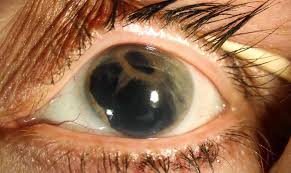
Triads in Ophthalmology
·
BÁLINT'S SYNDROME is loosely
associated with a triad of visuospatial dysfunctions: simultanagnosia, optic
ataxia, and ocular motor apraxia
·
BEHÇET'S DISEASE was initially described
by Behçet in 1937 as a triad of oral ulcers, genital ulcers and hypopyon
uveitis.
·
CEREBRAL WHIPPLE'S DISEASE includes a
triad of somnolence, dementia and ophthalmoplegia.
·
CONE DEGENERATION includes the hallmark
triad of progressive central acuity loss, color vision disturbances and
photophobia.
·
CONGENITAL GLAUCOMA includes the commonly
described triad of epiphora, blepharospasm and photophobia .
·
CONGENITAL RUBELLA RETINOPATHY includes
the triad of cataracts, deafness and congenital heart disease which was first
described by Gregg in 1941
·
CONGENITAL TOXOPLASMOSIS includes the
classic triad of retinochoroiditis, hydrocephalus and intracranial
calcifications although other signs such as fever, rash, hepatosplenomegaly,
and seizures may occur if the infection is acquired earlier than the third
trimester.
·
DE MORSIER'S SYNDROME, the congenital
syndrome of septo-optic dysplasia includes the clinical triad of short stature,
nystagmus and optic disc hypoplasia.
·
FECHTNER'S SYNDROME includes triad of
nephritis, sensorineural hearing loss and eye abnormalities
·
GAUCHER DISEASE, classic Gaucher triad
consists of trismus, strabismus, and opisthotonus.
·
HORNER'S SYNDROME includes classic triad
of ptosis, miosis and ipsilateral anhidrosis of the face
·
INTRAOPERATIVE FLOPPY IRIS SYNDROME
described by John Campbell and David F. Chang in 2005 which includes the triad
by a flaccid iris stroma that undulates and billows in response to ordinary
intraocular fluid currents ,a propensity for the floppy iris stroma to prolapse
toward the phaco and side-port incisions, despite proper wound construction and
progressive intraoperative pupil constriction despite standard preoperative
pharmacologic measures designed to maximize dilation (topical cycloplegics,
phenylephrine, and nonsteroidal anti-inflammatory medications).
·
KEARNS–SAYRE SYNDROME includes the triad
of external ophthalmoplegia, pigmentary retinopathy and cardiac conduction
block during the first or second decade of life
·
LAMBERT–EATON MYASTHENIC SYNDROME
includes triad of muscle weakness, autonomic dysfunction and hyporeflexia
·
MILLER-FISHER SYNDROME consists of the
triad of ataxia, ophthalmoplegia and areflexia .It is described as a variant of
Guillain-Barré syndrome.
·
OCULAR ISCHEMIC SYNDROME includes the
classic triad includes midperipheral dot hemorrhages, dilated retinal veins and
iris neovascularization.
·
OCULAR TILT REACTION consists of the
triad of skew deviation, cyclotorsion of both eyes and paradoxical head tilt,
all to the same side—that of the lower eye
·
OPTIC NERVE SHEATH MENINGIOMA are
characterized by the clinical triad of the presence of optociliary venous
shunts on the disc, when accompanied by diffuse disc edema (eventually replaced
slowly by pallor) and insidious visual loss
·
OSTEOGENESIS IMPERFECTA originally
described late in the 18th century, osteogenesis imperfecta (Van der Hoeve's
syndrome, brittle bone disease) was not well described as a clinical syndrome
until 1918 by Van der Hoeve. The syndrome includes triad of brittle bones, blue
scleras and deafness (otosclerosis) .
·
PHARYNGOCONJUNCTIVAL FEVER by
Adenoviruses sometimes produces the classic triad of fever, pharyngitis and
acute follicular conjunctivitis.
·
PIERRE ROBIN SYNDROME includes the
diagnostic triad of micrognathia, glossoptosis and cleft palate.
·
PIGMENTARY GLAUCOMA includes the classic
triad consists of corneal pigmentation (Krukenberg's spindle); slit-like,
radial, midperipheral iris transillumination defects; and heavy accumulation of
pigment in the trabecular meshwork.
·
PRESUMED OCULAR HISTOPLASMOSIS SYNDROME
includes the triad: peripapillary atrophy, “punched-out” chorioretinal lesions
and disciform macular scarring in young and middle-aged adults
·
REITER'S SYNDROME was originally
described by the classic triad of arthritis, urethritis and conjunctivitis. In
1981, the American Rheumatism Association expanded this original set of
criteria .
·
SCHWARTZ'S SYNDROME includes triad of
rhegmatogenous retinal detachment, uveitis and glaucoma
·
SJÖGREN'S SYNDROME Sjögren's syndrome
originally was described as a triad of dry eyes, dry mouth, and Arthritis (dry
joints). It subsequently has become apparent that Sjögren's syndrome may
coexist with a variety of other connective tissue diseases
·
SPASMUS NUTANS occurs in the first year
of life and includes triad of pendular nystagmus, head nodding and torticollis.
·
STURGE-WEBER SYNDROME includes triad of
port wine facial telangiectasis (nevus flammeus) in the distribution of the
trigeminal nerve that respects the vertical midline, ipsilateral
glaucoma(ipsilateral buphthalmos)and contralateral seizures caused by
ipsilateral leptomeningeal hemangiomatosis.
·
UGH SYNDROME, an IOL-related inflammation
which involves the triad of uveitis, glaucoma and hyphema. UGH syndrome
occurred more frequently in the 1970s, when iris-fixed lenses were commonly
used.
·
Triads …from Eye Anatomy
The rod and cone terminals are organized as invaginating synapses, termed triads, each containing a single presynaptic ribbon, two lateral processes from horizontal cells, and a single central process from a bipolar cell. Each rod spherule contains a single triad; each cone pedicle contains several triads.
The rod and cone terminals are organized as invaginating synapses, termed triads, each containing a single presynaptic ribbon, two lateral processes from horizontal cells, and a single central process from a bipolar cell. Each rod spherule contains a single triad; each cone pedicle contains several triads.
- compiled & published by Dr Dhaval Patel MD AIIMS
